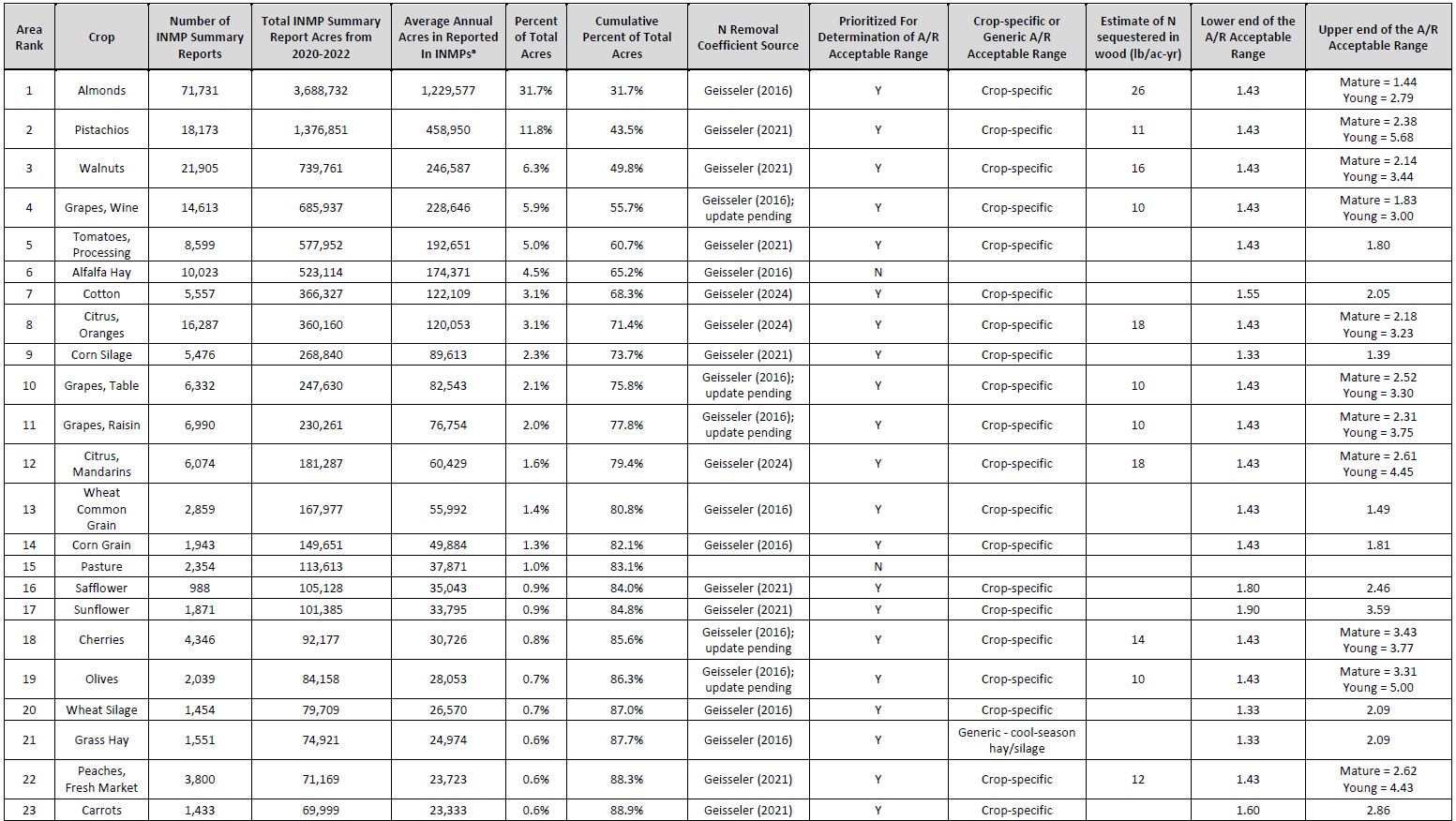A/R Acceptable Ranges – Understanding Crop-Specific
Nitrogen Use Efficiency
To protect groundwater quality and improve nitrogen (N) management, a balance is needed between the amount of nitrogen applied (A) and the amount removed (R) at harvest or stored in perennial tissues. As required by the General Order, the Central Valley Water Quality Coalition, with 12 other water quality coalitions, have developed A/R Acceptable Ranges, for Central Valley crop varieties, to help growers optimize nitrogen use while considering real-world growing conditions.


What are A/R Acceptable Ranges?
A/R Acceptable Ranges set benchmarks for nitrogen application efficiency across different crops. These ranges:
• Help identify if too much nitrogen is being applied, reducing waste, identifying cost savings, and revealing potential water contamination.
• Provide realistic efficiency targets based on crop needs, soil conditions, local climate, and environmental factors.
• Allow for adjustments as new research, technologies, and farming practices evolve.
Crop-Specific Nitrogen Removal Rates: Understanding how much nitrogen each crop takes up and stores
Why This Matters for Growers

Improve nitrogen use efficiency

Reduce costs and environmental impacts

Comply with water quality regulations
Understanding the Lower & Upper Ends
Lower End (Assumes most optimal conditions)
A/R values near 1 indicate applied N is closer to the amount removed
- Represents the best-case scenario where nitrogen is used most efficiently under optimal conditions.
- Based on scientific research, crop nitrogen uptake, and recommendations from University of California agricultural advisors.
- While achievable in some cases, this level of efficiency may not be practical for all fields due to varying conditions.
Upper End (Assumes real-world conditions)
A/R values closer to 2 or above indicate twice as much N was applied than removed
- Accounts for real-world conditions and practical challenges like soil differences, weather extremes, pest infestations, and market pressures.
- Based on data reported by growers across the Central Valley.
- Provides a reasonable benchmark that most growers should be able to stay within over multiple years.
How are these Limits Determined?
To establish these ranges, experts analyze:
- Scientific Literature & UC Extension Materials: Research-backed recommendations for nitrogen use.
- Grower-Reported Data: Nitrogen application and yield reports from farmers.
- Crop-Specific Nitrogen Removal Rates: Understanding how much nitrogen each crop takes up and stores.
The ranges will be updated regularly to reflect the latest research and farming advancements, ensuring they remain relevant and effective.

Crop-Specific Multi-Year Acceptable Ranges of A/R
Crops with limited data and information to inform credible A/R Ranges have been excluded from this table.








| Crop | Estimate of N Sequestered in Wood (lb/ac-yr) | Lower End of A/R Range | Upper End of A/R Range |
|---|---|---|---|
| Almonds | 26 | 1.43 | Mature = 1.44, Young = 2.79 |
| Pistachios | 11 | 1.43 | Mature = 2.38, Young = 5.68 |
| Walnuts | 16 | 1.43 | Mature = 2.14, Young = 3.44 |
| Grapes, Wine | 10 | 1.43 | Mature = 1.83, Young = 3.00 |
| Tomatoes, Processing | 1.43 | 1.80 | |
| Cotton | 1.55 | 2.05 | |
| Citrus, Oranges | 18 | 1.43 | Mature = 2.18, Young = 3.23 |
| Corn Silage | 1.33 | 1.39 | |
| Grapes, Table | 10 | 1.43 | Mature = 2.52, Young = 3.30 |
| Grapes, Raisin | 10 | 1.43 | Mature = 2.31, Young = 3.75 |
| Citrus, Mandarins | 18 | 1.43 | Mature = 2.61, Young = 4.45 |
| Wheat, Common Grain | 1.43 | 1.49 | |
| Corn Grain | 1.43 | 1.81 | |
| Safflower | 1.80 | 2.46 | |
| Sunflower | 1.90 | 3.59 | |
| Cherries | 14 | 1.43 | Mature = 3.43, Young = 3.77 |
| Olives | 10 | 1.43 | Mature = 3.31, Young = 5.00 |
| Wheat Silage | 1.33 | 2.09 | |
| Grass Hay | 1.33 | 2.09 | |
| Peaches, Fresh Market | 12 | 1.43 | Mature = 2.62, Young = 4.43 |
| Carrots | 1.60 | 2.86 | |
| Potatoes | 1.50 | 2.54 | |
| Garlic | 1.50 | 2.22 | |
| Pomegranates | 10 | 1.43 | Mature = 2.32, Young = 4.00 |
| Citrus, Lemons | 18 | 1.43 | Mature = 2.27, Young = 3.44 |
| Plums | 13 | 1.43 | Mature = 3.07, Young = 3.85 |
| Wheat Hay | 1.33 | 2.09 | |
| Nectarines | 12 | 1.43 | Mature = 2.50, Young = 4.04 |
| Onion | 1.50 | 3.84 | |
| Prunes | 13 | 1.43 | Mature = 3.81, Young = 5.25 |
| Melons, Cantaloupe | 1.43 | 2.64 | |
| Citrus, All Other | 18 | 1.43 | Mature = 2.18, Young = 3.23 |
| Sweet Potatoes | 1.43 | 2.12 | |
| Beans, Dry | 0.00 | 1.93 | |
| Oat Silage | 1.33 | 1.89 | |
| Oat Hay | 1.33 | 1.89 | |
| Sudan Hay | 1.33 | 1.48 | |
| Corn, Sweet | 2.10 | 3.79 | |
| Figs | 10 | 1.43 | Mature = 2.38, Young = 5.68 |
| Tomatoes, Fresh Market | 2.40 | 3.15 | |
| Melons, Watermelon | 1.90 | 4.96 | |
| Vegetables, Mixed | 1.60 | 4.00 | |
| Triticale Grain | 1.40 | 1.55 | |
| Peaches, Processing | 12 | 1.43 | Mature = 1.91, Young = 3.87 |
| Berries | 5 | 1.43 | 9.87 |
| Pears | 10 | 1.43 | 3.58 (insufficient acreage to determine young vs mature) |
| Peaches | 12 | 1.43 | Mature = 2.62, Young = 4.43 |
| Beans, Garbanzo | 0.00 | 1.58 | |
| Small Grain | 1.43 | 1.49 | |
| Apricots | 12 | 1.43 | 2.70 (insufficient acreage to determine young vs mature) |
| Lettuce | 1.60 | 4.00 | |
| Cucumber | 2.00 | 6.77 | |
| Small Grain Hay | 1.33 | 2.09 | |
| Melons, Honeydew | 1.60 | 2.74 | |
| Small Grain Silage | 1.33 | 2.09 | |
| Pecans | 16 | 1.43 | Mature = 2.38, Young = 5.68 |
| Lettuce, Iceberg | 1.60 | 4.00 | |
| Kiwi | 10 | 1.43 | 6.30 (insufficient acreage to determine young vs mature) |
| Broccoli | 2.40 | 4.00 | |
| Sorghum Silage | 1.33 | 2.00 | |
| Wheat Durum Grain | 1.43 | 1.57 | |
| Sorghum Hay | 1.33 | 2.00 | |
| Citrus, Grapefruit | 18 | 1.43 | Mature = 2.18, Young = 3.23 |
| Peppers, Bell | 1.60 | 4.21 | |
| Ryegrass Hay | 1.33 | 2.09 | |
| Barley Grain | 1.43 | 1.94 | |
| Pumpkins | 1.60 | 4.00 | |
| Oat Grain | 1.43 | 1.82 | |
| Sorghum Grain | 1.43 | 1.66 | |
| Cabbage | 1.60 | 4.10 | |
| Beans, Lima | 0.00 | 1.18 | |
| Triticale Silage | 1.33 | 2.09 | |
| Grapes | 10 | 1.43 | Mature = 2.52, Young = 3.30 |
| Persimmons | 12 | 1.43 | Mature = 2.62, Young = 4.43 |
| Cauliflower | 1.60 | 4.00 | |
| Apples | 10 | 1.43 | 3.58 (insufficient acreage to determine young vs mature) |
| Onion, Dehydrator | 1.50 | 3.84 | |
| Beans, Blackeye | 0.00 | 1.78 | |
| Squash | 1.60 | 4.00 | |
| Peppers | 1.60 | 4.21 | |
| Parsley | 1.60 | 4.00 | |
| Grass Silage | 1.33 | 2.09 | |
| Tomatoes | 1.43 | 1.80 | |
| Beans, Green | 0 | 5.54 | |
| Kale | 1.60 | 4.00 | |
| Lettuce, Romaine | 1.60 | 4.00 | |
| Asparagus | 2.00 | 16.00 | |
| Wheat Straw | 1.33 | 2.09 | |
| Melons | 1.60 | 4.96 | |
| Spinach | 1.60 | 4.00 | |
| Triticale Hay | 1.33 | 2.09 | |
| Radish | 1.60 | 4.00 | |
| Citrus, Tangelos | 18 | 1.43 | Mature = 2.18, Young = 3.23 |
| Fruit Tree | 12 | 1.43 | Mature = 2.62, Young = 4.43 |
| Strawberries | 1.60 | 4.00 | |
| Barley Straw | 1.33 | 2.09 | |
| Small Grain Straw | 1.33 | 2.09 |
